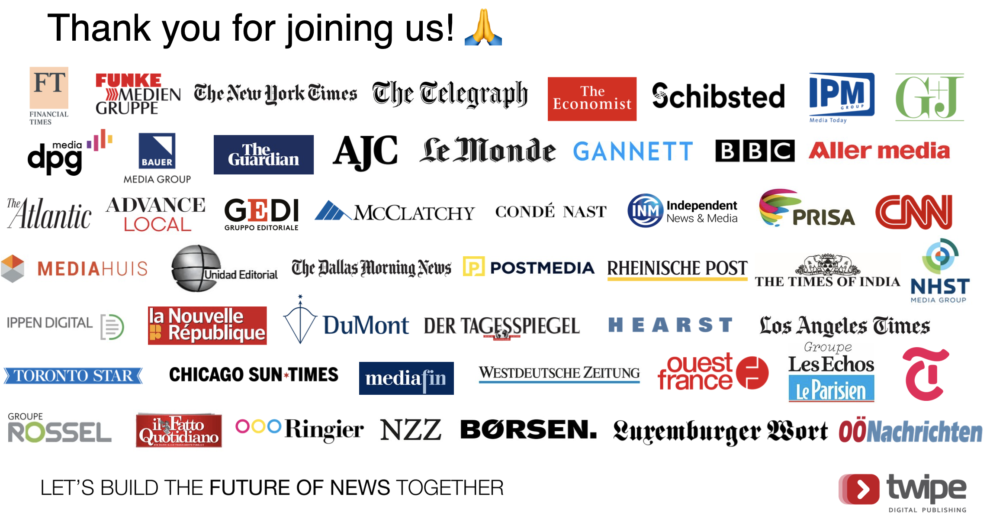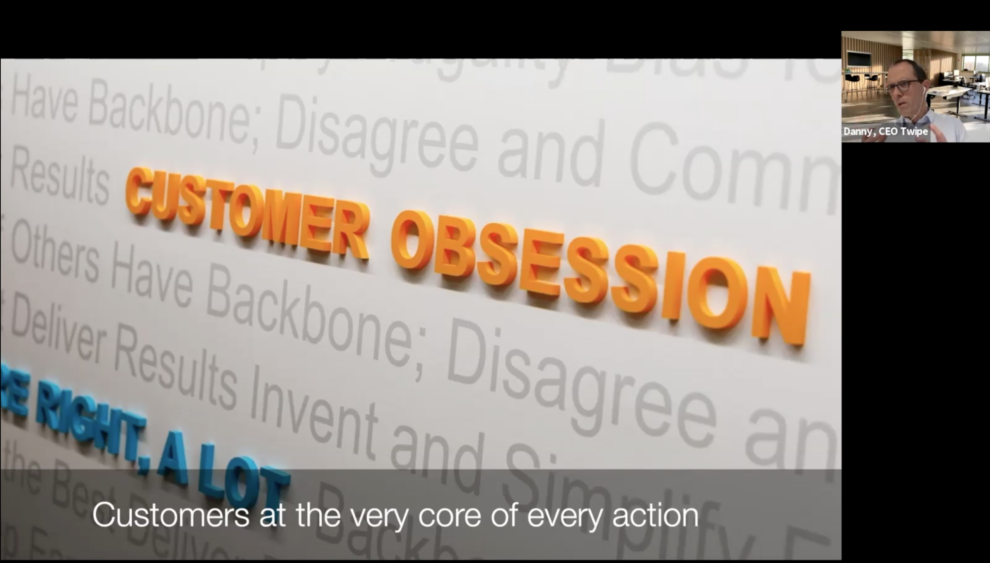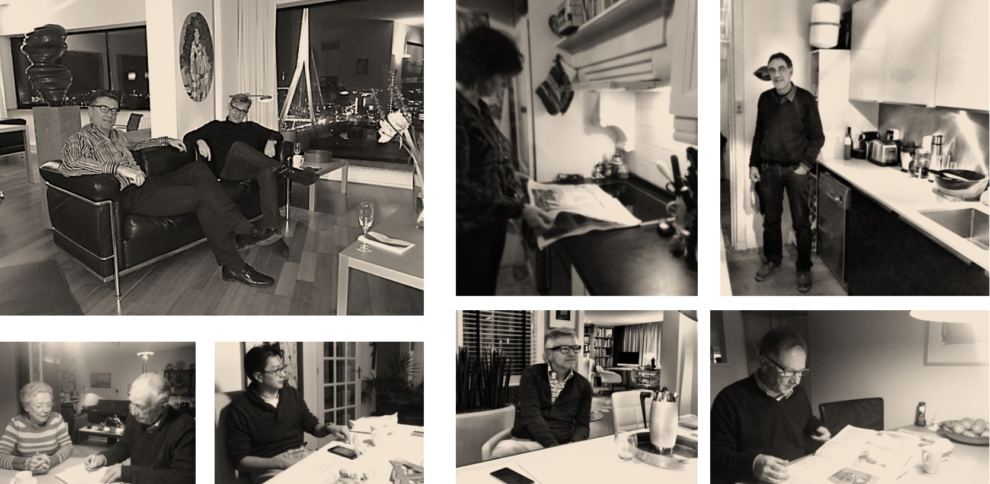Blog
Why it must always be Day One for newspapers
This week we had the final webinar for the year in our Future of News series. With attendees coming from 25 different countries, we were able to have a truly international discussion on what Day One means for legacy news organisations. We were joined on stage by three leading CEOs, Nykia Wright from Chicago Sun-Times, Rien van Beemen from Mediahuis Netherlands, and Thomas Schultz-Homberg from DuMont Regional Media.

What does it mean to be Day One?
The idea of “Day One” is something Jeff Bezos has credited for the phenomenal success of Amazon. For him, it must always be Day One, as Day Two means “Stasis. Followed by irrelevance. Followed by excruciating, painful decline. Followed by death.” This explains how startups can lose their advantage as they grow, but it can also apply to legacy organisations. As organisations grow, complexity grows as well and it risks becoming slow and rigid.
For an organisation to still be on Day One, there are a few key principles they must follow, such as customer obsession, high-velocity decision making, ongoing innovation, and relentless improvement. How we can make sure it is Day One is clearly an important topic in the news industry, as only 17% of attendees believe their organisation has adopted similar principles to Day One, while 24% believe their organisation hasn’t adopted any of the principles. Of the Day One principles, the most adopted one is ongoing innovation, with 39% agreeing they had this at their organisation.
We also asked attendees why it isn’t Day One for their organisations and what has been the main barrier in their digital growth. Limited resources, whether it be money (18%), people (12%), or technology (29%) explained some of it but for many attendees it is their company culture slowing them down (41%).
Changing corporate culture is key first step
For the first part of the roundtable, we heard from each CEO about their company’s culture and how it has evolved over time. Quickly we saw a consensus about the importance of empowering the people closest to an issue to make decisions.
For Nykia Wright, CEO of Chicago Sun-Times in the US, one thing that helped turn around the struggling newspaper was an entirely new leadership team. While most members had experience in the newspaper industry, they were new to the Chicago Sun-Times, meaning they had fresh eyes for the micro-economic problem while still having a deep understanding of the macro-economic problems facing the industry. There was certainly a lot of work for them: Chicago Sun-Times didn’t have digital subscriptions until April 2018, basically 20 years behind The New York Times. To get the whole company aligned towards this change, they had to break down the silos between teams. This has also meant empowering the people closest to the customers to find new innovations.
Innovation comes from people who are closest to the customer, and are coming up with the most creative ideas to either save money, or to grow. We can’t rely on the senior leadership team to do it, because we are the farthest from the customer.
Nykia Wright, CEO of Chicago Sun-Times
In Germany, Thomas Schultz-Homberg CEO of DuMont Regional Media faced 400 years of legacy as a publishing house, with their flagship newspaper published continuously since 1805. To change their company culture, it has been important to make sure it is not just coming from the senior management. Instead, you have to gain the trust of everyone and align together on this one goal. Cross functional teams and embracing technology have helped achieve this.
When Rien van Beemen joined Mediahuis Netherlands, he saw the decision making process was slowing down the pace of innovation. Everybody had to discuss everything together and so decisions were taking a long time. That’s why the first thing he set to change was to make sure that launching products and adjustments to apps should be able to happen within a month. To achieve this, they even had a phase when they changed something on a daily basis so that this mindset would really spread throughout the whole company.
Rien van Beemen sees his role of CEO as one of facilitating, as the people closest to the topics should be making the decisions. Thomas Schultz-Homberg agreed with this framing: the role of the CEO is to be an evangelist and empower people to take action. Nykia Wright even calls some members of her leadership team her “boss” because there are very few unilateral decisions she will make. The team needs to overcommunicate and use data to make decisions.
When you are facing extinction, there are no egos in the room.
Nykia Wright, CEO of Chicago Sun-Times
Customer obsession: the North Star for everyone in your organisation
To see how we can directly apply the lessons from Amazon to news publishers, we heard from Stefan Seghers, who previously worked at Amazon and is now Chief Digital Officer at Roularta, the largest magazine publisher in Belgium. He shared that people are so empowered to make decisions that you might from one day to another be shifted to a new role so that you can focus full time on the new idea you proposed. But the key learning that newspapers can take from Amazon is the focus on customers at every level in the organisation.

Newspapers must truly be customer obsessed and with that comes wanting data on everything the customer does. At Roularta, they have implemented a CDP to tell them everything about the customer and the team is expected to look at the associated KPIs every day. The people closest to the customers, the Customer Service team, have risen to the forefront of every discussion. That’s one reason why at Chicago Sun-Times they brought their customer call center back to the US after previously moving it to Latin America. Nykia Wright explained that in the Midwest, people are particular about their accents (“uff da!”) so this move meant that subscribers felt more comfortable and their team could more quickly understand subscriber concerns.
Of the attendees, only 20% believe their organisation has a customer obsession. Still more organisations do follow up on reader metrics every day, with 57% following up every day with between 1 to 5 reader metrics. But there are extremes on either end with 7% having no reader metrics they follow up daily and 6% having more than 50!
At Mediahuis Netherlands, they have taken customer obsession to the next level as Rien van Beemen shared they are regularly visiting their readers at home. As part of a multi-disciplinary group, they will visit readers to see how they read the newspapers or visit the website in order to truly understand how their journalism fits into the daily routines of their readers. They even had for example journalists on the phone with readers who were trying to cancel their subscriptions so they could learn from that experience as well. While maybe not to this level, webinar attendees are still frequently in contact with their readers: 23% interact personally with readers daily while 47% interact monthly. Still that leaves 30% of attendees who never personally interact with readers!

This distinction between readers and customers was also an important topic during the roundtable. Who are we talking about when we say customers, just subscribers or all readers? For Thomas Schultz-Homberg, their customers are all readers since every reader can become a subscriber. Amongst our attendees, we can also see pretty clearly that the industry has moved to focusing on subscribers specifically, with 66% of respondents defining this group as their main customer focus. Still 9% place a priority on advertisers, while 25% look at readers as a whole, even those who access content for free.
This division was also brought as a question from Mark Little, CEO of Kinzen, who wondered if by putting our content behind the paywall we are sacrificing our responsibility to serve the wider public good. For Nykia Wright, this isn’t a zero sum decision, it is important to still pay homage to the people who already understand the value of paying for news, while still educating the others. She highlighted the example of newsletters, which are free for all readers at Chicago Sun-Times, and can serve as a gateway to paying for news.
Quality journalism comes at a cost and it’s very important society realises this.
Rien van Beemen, CEO Mediahuis Netherlands
As we wrapped up the webinar we polled attendees on what the next webinar should focus on. Make sure to subscribe to our event mailing list to hear when we announce the next event in our Future of News series.
Other Blog Posts

Stay on top of the game
Subscribe to Twipe’s weekly newsletter to receive industry insights, case studies, and event invitations.
"(Required)" indicates required fields

